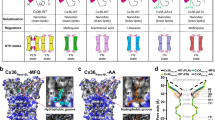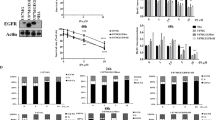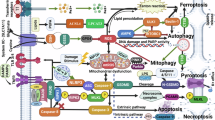Abstract
Decades of research have indicated that gap junction channels contribute to the propagation of apoptosis between neighboring cells. Inositol 1,4,5-trisphosphate (IP3) has been proposed as the responsible molecule conveying the apoptotic message, although conclusive results are still missing. We investigated the role of IP3 in a model of gap junction-mediated spreading of cytochrome C-induced apoptosis. We used targeted loading of high-molecular-weight agents interfering with the IP3 signaling cascade in the apoptosis trigger zone and cell death communication zone of C6-glioma cells heterologously expressing connexin (Cx)43 or Cx26. Blocking IP3 receptors or stimulating IP3 degradation both diminished the propagation of apoptosis. Apoptosis spread was also reduced in cells expressing mutant Cx26, which forms gap junctions with an impaired IP3 permeability. However, IP3 by itself was not able to induce cell death, but only potentiated cell death propagation when the apoptosis trigger was applied. We conclude that IP3 is a key necessary messenger for communicating apoptotic cell death via gap junctions, but needs to team up with other factors to become a fully pro-apoptotic messenger.
Similar content being viewed by others
Log in or create a free account to read this content
Gain free access to this article, as well as selected content from this journal and more on nature.com
or
Abbreviations
- AI:
-
apoptotic index
- AUC:
-
area under the curve
- BH4-Bcl-2:
-
BH4 domain of Bcl-2
- BIND:
-
a mutant BH4-Bcl-2 peptide in which the surface-accessible residues have been altered
- Cbx:
-
carbenoxolone
- Cx:
-
connexin
- CytC:
-
cytochrome C
- [Ca2+]i:
-
cytoplasmic Ca2+ concentration
- DAPI:
-
2′,6′-diamidino-2-phenylindole
- DMEM:
-
Dulbecco's modified Eagle's medium
- DTR:
-
dextran Texas Red
- ER:
-
endoplasmic reticulum
- EV:
-
empty vector
- GJ:
-
gap junction channel
- HBSS-Hepes:
-
Hanks’ balanced salt solution buffered with Hepes
- IDP:
-
IP3R-derived peptide
- IP3:
-
inositol 1,4,5-trisphosphate
- IP3R:
-
inositol 1,4,5-trisphosphate receptor
- NALC:
-
N-acetyl L-cysteine
- PBSD+:
-
PBS supplemented with Ca2+ and Mg2+
- PFA:
-
paraformaldehyde
- PI:
-
propidium iodide
- PLC:
-
phospholipase C
- PTP:
-
permeability transition pore
- ROS:
-
reactive oxygen species
- SCR:
-
scrambled version of BH4-Bcl-2
- SLDT:
-
scrape loading and dye transfer
- WT:
-
wild-type
References
Boehning D, van Rossum DB, Patterson RL, Snyder SH . A peptide inhibitor of cytochrome c/inositol 1,4,5-trisphosphate receptor binding blocks intrinsic and extrinsic cell death pathways. Proc Natl Acad Sci USA 2005; 102: 1466–1471.
Verkhratsky A . Calcium and cell death. Subcell Biochem 2007; 45: 465–480.
Decuypere JP, Monaco G, Bultynck G, Missiaen L, De Smedt H, Parys JB . The IP(3) receptor–mitochondria connection in apoptosis and autophagy. Biochim Biophys Acta 2011; 1813: 1003–1013.
Sammels E, Parys JB, Missiaen L, De Smedt H, Bultynck G . Intracellular Ca2+ storage in health and disease: a dynamic equilibrium. Cell Calcium 2010; 47: 297–314.
Szalai G, Krishnamurthy R, Hajnoczky G . Apoptosis driven by IP(3)-linked mitochondrial calcium signals. EMBO J 1999; 18: 6349–6361.
Dupont G, Combettes L, Leybaert L . Calcium dynamics: spatio-temporal organization from the subcellular to the organ level. Int Rev Cytol 2007; 261: 193–245.
Rong YP, Distelhorst CW . Bcl-2 protein family members: versatile regulators of calcium signaling in cell survival and apoptosis. Annu Rev Physiol 2008; 70: 73–91.
Boitano S, Dirksen ER, Sanderson MJ . Intercellular propagation of calcium waves mediated by inositol trisphosphate. Science 1992; 258: 292–295.
Saez JC, Berthoud VM, Branes MC, Martinez AD, Beyer EC . Plasma membrane channels formed by connexins: their regulation and functions. Physiol Rev 2003; 83: 1359–1400.
Decrock E, Vinken M, De Vuyst E, Krysko DV, D’Herde K, Vanhaecke T et al. Connexin-related signaling in cell death: to live or let die? Cell Death Differ 2009; 16: 524–536.
Decrock E, De Vuyst E, Vinken M, Van Moorhem M, Vranckx K, Wang N et al. Connexin 43 hemichannels contribute to the propagation of apoptotic cell death in a rat C6 glioma cell model. Cell Death Differ 2009; 16: 151–163.
Cusato K, Bosco A, Rozental R, Guimaraes CA, Reese BE, Linden R et al. Gap junctions mediate bystander cell death in developing retina. J Neurosci 2003; 23: 6413–6422.
Cusato K, Ripps H, Zakevicius J, Spray DC . Gap junctions remain open during cytochrome c-induced cell death: relationship of conductance to ‘bystander’ cell killing. Cell Death Differ 2006; 13: 1707–1714.
Frank DK, Szymkowiak B, Josifovska-Chopra O, Nakashima T, Kinnally KW . Single-cell microinjection of cytochrome c can result in gap junction-mediated apoptotic cell death of bystander cells in head and neck cancer. Head Neck 2005; 27: 794–800.
Udawatte C, Ripps H . The spread of apoptosis through gap-junctional channels in BHK cells transfected with Cx32. Apoptosis 2005; 10: 1019–1029.
Peixoto PM, Ryu SY, Pruzansky DP, Kuriakose M, Gilmore A, Kinnally KW . Mitochondrial apoptosis is amplified through gap junctions. Biochem Biophys Res Commun 2009; 390: 38–43.
Decrock E, Vinken M, Bol M, D’Herde K, Rogiers V, Vandenabeele P et al. Calcium and connexin-based intercellular communication, a deadly catch? Cell Calcium 2011; 50: 310–321.
Allbritton NL, Meyer T, Stryer L . Range of messenger action of calcium ion and inositol 1,4,5-trisphosphate. Science 1992; 258: 1812–1815.
Hofer T, Venance L, Giaume C . Control and plasticity of intercellular calcium waves in astrocytes: a modeling approach. J Neurosci 2002; 22: 4850–4859.
Assefa Z, Bultynck G, Szlufcik K, Nadif Kasri N, Vermassen E, Goris J et al. Caspase-3-induced truncation of type 1 inositol trisphosphate receptor accelerates apoptotic cell death and induces inositol trisphosphate-independent calcium release during apoptosis. J Biol Chem 2004; 279: 43227–43236.
Verbert L, Lee B, Kocks SL, Assefa Z, Parys JB, Missiaen L et al. Caspase-3-truncated type 1 inositol 1,4,5-trisphosphate receptor enhances intracellular Ca2+ leak and disturbs Ca2+ signalling. Biol Cell 2008; 100: 39–49.
Huang DC, Adams JM, Cory S . The conserved N-terminal BH4 domain of Bcl-2 homologues is essential for inhibition of apoptosis and interaction with CED-4. EMBO J 1998; 17: 1029–1039.
Rong YP, Bultynck G, Aromolaran AS, Zhong F, Parys JB, De Smedt H et al. The BH4 domain of Bcl-2 inhibits ER calcium release and apoptosis by binding the regulatory and coupling domain of the IP3 receptor. Proc Natl Acad Sci USA 2009; 106: 14397–14402.
Monaco G, Decrock E, Akl H, Ponsaerts R, Vervliet T, Luyten T et al. Selective regulation of IP(3)-receptor-mediated Ca(2+) signaling and apoptosis by the BH4 domain of Bcl-2 versus Bcl-Xl. Cell Death Differ 2011; e-pub ahead of print 5 August 2011.
Bruzzone R, Veronesi V, Gomes D, Bicego M, Duval N, Marlin S et al. Loss-of-function and residual channel activity of connexin26 mutations associated with non-syndromic deafness. FEBS Lett 2003; 533: 79–88.
Beltramello M, Piazza V, Bukauskas FF, Pozzan T, Mammano F . Impaired permeability to Ins(1,4,5)P3 in a mutant connexin underlies recessive hereditary deafness. Nat Cell Biol 2005; 7: 63–69.
Anselmi F, Hernandez VH, Crispino G, Seydel A, Ortolano S, Roper SD et al. ATP release through connexin hemichannels and gap junction transfer of second messengers propagate Ca2+ signals across the inner ear. Proc Natl Acad Sci USA 2008; 105: 18770–18775.
Nutt LK, Chandra J, Pataer A, Fang B, Roth JA, Swisher SG et al. Bax-mediated Ca2+ mobilization promotes cytochrome c release during apoptosis. J Biol Chem 2002; 277: 20301–20308.
Peng TI, Jou MJ . Oxidative stress caused by mitochondrial calcium overload. Ann N Y Acad Sci 2010; 1201: 183–188.
Tang EH, Vanhoutte PM . Gap junction inhibitors reduce endothelium-dependent contractions in the aorta of spontaneously hypertensive rats. J Pharmacol Exp Ther 2008; 327: 148–153.
Dupont G, Koukoui O, Clair C, Erneux C, Swillens S, Combettes L . Ca2+ oscillations in hepatocytes do not require the modulation of InsP3 3-kinase activity by Ca2+. FEBS Lett 2003; 534: 101–105.
De Smedt F, Verjans B, Mailleux P, Erneux C . Cloning and expression of human brain type I inositol 1,4,5-trisphosphate 5-phosphatase. High levels of mRNA in cerebellar Purkinje cells. FEBS Lett 1994; 347: 69–72.
Morales AP, Carvalho AC, Monteforte PT, Hirata H, Han SW, Hsu YT et al. Endoplasmic reticulum calcium release engages Bax translocation in cortical astrocytes. Neurochem Res 2011; 36: 829–838.
Peixoto PM, Lue JK, Ryu SY, Wroble BN, Sible JC, Kinnally KW . Mitochondrial apoptosis-induced channel (MAC) function triggers a Bax/Bak-dependent bystander effect. Am J Pathol 2011; 178: 48–54.
Scorrano L, Oakes SA, Opferman JT, Cheng EH, Sorcinelli MD, Pozzan T et al. BAX and BAK regulation of endoplasmic reticulum Ca2+: a control point for apoptosis. Science (New York, NY) 2003; 300: 135–139.
Carvalho AC, Sharpe J, Rosenstock TR, Teles AF, Youle RJ, Smaili SS . Bax affects intracellular Ca2+ stores and induces Ca2+ wave propagation. Cell Death Differ 2004; 11: 1265–1276.
Oakes SA, Scorrano L, Opferman JT, Bassik MC, Nishino M, Pozzan T et al. Proapoptotic BAX and BAK regulate the type 1 inositol trisphosphate receptor and calcium leak from the endoplasmic reticulum. Proce Natl Acad Sci USA 2005; 102: 105–110.
Niessen H, Harz H, Bedner P, Kramer K, Willecke K . Selective permeability of different connexin channels to the second messenger inositol 1,4,5-trisphosphate. J Cell Sci 2000; 113 (Part 8): 1365–1372.
Baumgartner HK, Gerasimenko JV, Thorne C, Ferdek P, Pozzan T, Tepikin AV et al. Calcium elevation in mitochondria is the main Ca2+ requirement for mitochondrial permeability transition pore (mPTP) opening. J Biol Chem 2009; 284: 20796–20803.
Sims CE, Allbritton NL . Metabolism of inositol 1,4,5-trisphosphate and inositol 1,3,4,5-tetrakisphosphate by the oocytes of Xenopus laevis. J Biol Chem 1998; 273: 4052–4058.
Acknowledgements
This work was impossible without the technical assistance of Ms Kirsten Leurs, Ms Anneleen Decock, Ms Marlies Bekaert, Ms Liesbeth Heyndrickx and Mr Eric Tack. We also gratefully acknowledge Mr Timothy Voorspoels for developing analysis tools and software. We thank Dr. D Boehning (Department of Neuroscience and Cell Biology, University of Texas Medical Branch, Galveston, TX, USA) for providing the IP3RCYT peptide. Our work is supported by: the Fund for Scientific Research Flanders (FWO-Vlaanderen), Belgium (G.0140.08, G.0134.09, G.0298.11N and WO.005.10N) and the Interuniversity Attraction Poles Program (Belgian Science Policy, project P6/31) assigned to LL; FWO (G.072810) assigned to DVK; a Methusalem grant (BOF09/01M00709) from the Flemish Government assigned to PV; FWO (G.0788.11N), the Research Council of the KU Leuven via OT START-1 (SRT/10/044) and the Interuniversity Attraction Poles Program (P6/28) assigned to GB; and the Interuniversity Attraction Poles Program (P6/28) assigned to CE.
Author information
Authors and Affiliations
Corresponding author
Ethics declarations
Competing interests
The authors declare no conflict of interest.
Additional information
Edited by RA Knight
Rights and permissions
About this article
Cite this article
Decrock, E., Krysko, D., Vinken, M. et al. Transfer of IP3 through gap junctions is critical, but not sufficient, for the spread of apoptosis. Cell Death Differ 19, 947–957 (2012). https://doi.org/10.1038/cdd.2011.176
Received:
Revised:
Accepted:
Published:
Issue date:
DOI: https://doi.org/10.1038/cdd.2011.176
Keywords
This article is cited by
-
A comparative pharmacogenomic analysis of three classic TCM prescriptions for coronary heart disease based on molecular network modeling
Acta Pharmacologica Sinica (2020)
-
Cx43 channels and signaling via IP3/Ca2+, ATP, and ROS/NO propagate radiation-induced DNA damage to non-irradiated brain microvascular endothelial cells
Cell Death & Disease (2020)
-
Gap junctions and hemichannels: communicating cell death in neurodevelopment and disease
BMC Cell Biology (2017)
-
Mitochondrial Cx43 hemichannels contribute to mitochondrial calcium entry and cell death in the heart
Basic Research in Cardiology (2017)
-
Connexins: substrates and regulators of autophagy
BMC Cell Biology (2016)



